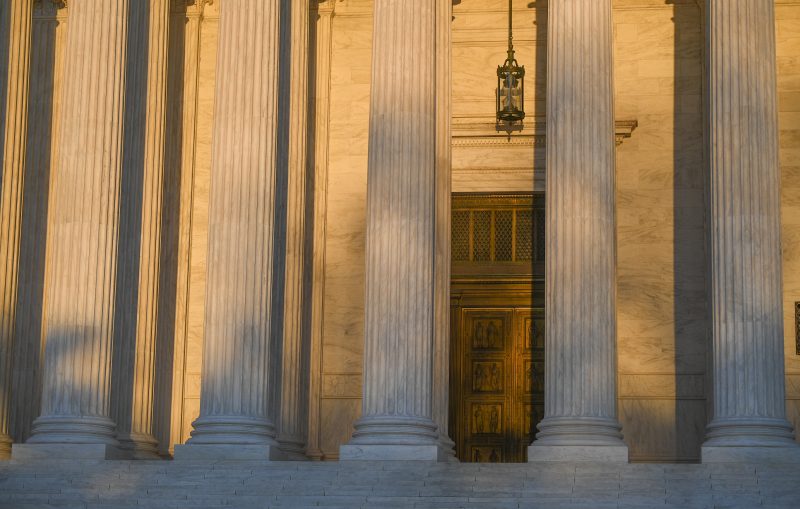It doesn’t happen often with this Supreme Court, but federal labor leaders are celebrating a strong pro-union decision written by an archconservative justice.
To the consternation of small-government champions, the ruling also confirmed the power of a little-known federal agency over a state government militia, while granting union officials welcome respite from other hostile opinions.
The ramifications of the decision could be far-reaching, fear union opponents, who see it as a gateway to intrusive federal power in the workplace.
Led by Justice Clarence Thomas, the 7-2 decision stopped the Ohio National Guard from unilaterally reversing a payroll union dues collection practice, while declaring itself exempt from a key federal labor law.
The May 18 decision allows voluntary paycheck dues deductions for “dual-status” civilian members of the National Guard represented by the American Federation of Government Employees (AFGE). Dual-status employees are full-time civilian employees of the National Guard, who also serve as part-time uniformed members of the military. The opinion refers to them as “rare-birds” who “occupy both civilian and military roles.”
They provide a variety of tasks, including administrative, information technology and maintenance services to keep the state’s Air and Army National Guard mission ready. Thomas’s opinion also confirms the ability of the Federal Labor Relations Authority (FLRA) to resolve disputes involving Nation Guard units that report to both state and federal officials. The Ohio Guard had appealed FLRA rulings in favor of the union’s unfair labor practice complaints. FLRA’s decision was affirmed by the U.S. Court of Appeals for the Sixth Circuit and now by the high court.
Under the Federal Service Labor-Management Relations Act, “a State National Guard acts as a federal agency … when it hires and supervises dual-status technicians serving in their civilian role,” Thomas wrote. They are “ultimately employees of the Secretaries of the Army and the Air Force … subject to federal civil-service requirements.”
In 2016, after 45 years of collective bargaining between AFGE and the National Guard, state officials announced that the National Guard was no longer bound by the labor relations statute and stopped withholding payroll union dues payments for 89 employees, according to the union’s brief, submitted by AFGE Assistant General Counsel Matthew W. Milledge.
Ohio officials argued that the FLRA has no power over a state entity. Congress, Ohio’s brief said, empowered FLRA to regulate the labor practices of federal agencies only, that is: “Establishments within the executive branch.” But Ohio also acknowledged: “Nearly every circuit has already uncritically held that federal law empowers the Authority to issue orders to state militias, and to do so even with respect to the parts of those militias that are not employed in the Service of the United States.’”
Nonetheless, Ohio’s brief urged the high court to reverse those decisions, saying, counterintuitively that “the uniformity of the lower-court decisions is all the more reason to hear this case.”
Briefs from the pro-Trump America First Policy Institute and the Americans for Fair Treatment, which works against public-sector unions, demonstrated the importance of the case to conservatives, who fought FLRA’s ruling.
Americans for Fair Treatment claimed that FLRA’s action means “it can transfigure all manner of states, localities, territories, Indian tribes, universities, and non-profits nationwide into federal agencies and give them orders to engage in collective bargaining as it sees fit.” Its brief also said the agency’s decision amounts to an “expansion of FLRA’s jurisdiction [that] inexorably means that the First Amendment rights of untold thousands will be violated.” Because union members only can withdraw their dues withholding after one year, Americans for Fair Treatment said that amounts to “forced membership.”
America First, led by former Trump administration appointees, showed its anti-federal union stance in a brief that said its “research demonstrates just how intrusive, time-consuming, and wasteful federal-sector collective bargaining can be.” It outlined “all the burdens associated” with basic labor-management negotiations, “including participating in negotiations, grievance proceedings, and unfair labor practice proceedings.”
Two conservative justices, Samuel A. Alito, Jr. and Neil M. Gorsuch, disagreed with Thomas’s ruling. Because the National Guard and the Ohio Adjutant General’s Department, which oversees the militia, “are not actually federal agencies,” Alito wrote, “the FLRA lacks jurisdiction” over them. Gorsuch joined the dissent, which said federal designation of the National Guard to act as a federal agency does not make it a federal agency. “Just because A is designated to exercise the authority of B,” Alito wrote, “it does not follow that A is B.”
Elisabeth Messenger, CEO of Americans for Fair Treatment, was surprised by the majority’s opinion. “This decision was unexpected, given the Court’s recent rulings — including Janus v. AFSCME – that affirmatively protect the First Amendment rights of public employees,” she said by email, referring to a 2018 Supreme Court opinion that left unions fuming.
The Janus ruling said public-sector employees who are not union members can’t be forced to pay union dues even though they benefit from union representation. In a 2021 decision, the high court struck down a California provision allowing union representatives to organize on growers’ land. And this week, the court issued a ruling easing the way for employers to sue over property damage resulting from labor strikes.
Based on justices’ questions during the National Guard oral arguments, AFGE Deputy General Counsel Andres M. Grajales was not surprised at who dissented or the final decision. The union rights for the dual-status employees are “an inescapable and unavoidable conclusion,” he said by phone. “Ohio’s arguments only make sense if you ignored the comprehensive statutory scheme that governs technicians.”
It was Grajales’s first time participating in high court oral arguments. He described the January experience as “intense, intense.” Unlike appearing before lower courts, lawyers at the Supreme Court not only argue the application of the law, but also “what the law should be” because the justices can overturn precedent.
The Ohio decision, he said, is important because it reinforces “the rights of federal sector unions to exist and to collectively bargain and to work in a civilian capacity.”



























